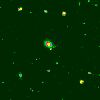| ING Media Archival Record |
| ITEM REFERENCE | 1820 |
| PERMANENT LINK | https://astro.ing.iac.es/outreach/?1820 |
| EXTACCESS | yes |
| TYPE2 | Image archive |
| TITLE | A high-redshift supernova |
| KEYWORDS | Distant universe;Supernovae |
| DATE | 1998-07-01 |
| ABSTRACT | Studies based on observations of supernovae in the farthest reaches of deep space indicate that the universe will expand forever because there isn enough mass in the universe for its gravity to slow the expansion, which started with the Big Bang. Image 1 was taken using the INT and it corresponds to a high-redshift type Ia supernova thousands of millions of light years away. When a star explodes as a type Ia supernova its brightness is similar to the host galaxy. This latter feature along with the possibility of calibrating their maximum brightness, make type Ia supernovae the best known standard candles to investigate the geometry and the dynamics of our universe. This is a CCD image obtained with the Wide Field Camera on the Isaac Newton Telescope. PDF version: https://www.ing.iac.es/PR/dissemination/highz.pdf |
| CREDIT | Javier Mendez (ING), Pilar Ruiz-Lapuente (University of Barcelona) and Nic Walton (ING) |
| TELESCOPE | INT |
| INSTRUMENT | WFC |
| THUMB_75 | 
https://www.ing.iac.es/PR/science/highzs.jpg |
| FILES | JPG (46K) 600×598 pixels
TIF (220K) 1018×1014 pixels |
| TIMESTAMP | 2024-08-25 22:54:24 |
| USAGE | For publication or display (electronic or otherwise), all photos, images or videos must be credited: "Photo/image/video courtesy of the Isaac Newton Group of Telescopes, La Palma" unless otherwise noted in the provided credit line. Please contact ING's Public Relations Officer (outreach  ing.iac.es) with all the details of the use. |

